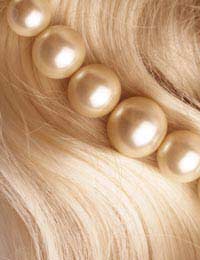Bleaching Your Hair

If you're an avid reader of hair care articles, you'll have come across many that advise you to avoid bleach and talk about the damage it can do to your hair. But the truth is that bleached hair can look good, and it really works for some people. If you're considering bleaching your hair, what issues should you consider, how should you go about it, and how can you make sure it remains in the best possible condition?
Is Bleached Hair Right for You?
As with all hair colour changes, bleaching is something you need to think about carefully - it doesn't work for everyone. This is especially true if you're intending to go platinum blond. Mid-toned shades suit most people, but very pale hair can change the way your whole face looks, changing the patterns of light and shadow across your skin. A good way to test the effect is to see how you look with a white towel or scarf wrapped around your face.Pale bleached hair can be flattering to older faces, softening the appearance of lines. Unfortunately it is less generous when it comes to blemishes, highlighting red patches and colour imperfections in the skin. Very pale and very dark skinned people can look good with bleached hair, but ruddy-skinned people will generally need to wear a lot of make-up to create a skin tone that works with it.
If you have naturally dry hair or afro hair, bleaching can be very hard on it and lead to breakages. If you must bleach hair like this, it's best to get it done professionally in a salon. Whatever your hair type, bleached hair works better in short styles, for the simple reason that it doesn't have the same life expectancy as untreated hair. If you keep it short you can keep it looking good.
How to Bleach your Hair
For most people with healthy hair, bleaching can be done just as well at home as in a salon. There are just a few rules you need to stick to:-- Always wear plastic or latex gloves to protect your hands.
- Be very careful to protect your eyes. If you do get bleach in them, rinse it out immediately with lots of cold water.
- Choose the right intensity of bleach for the look you want. Never use bleach stronger that 20 volume peroxide against your scalp. Stronger bleach is only safe for highlighting.
- Make sure your hair is very clean before you start.
- Never leave the bleach on your hair for longer than advised, even if your hair is very dark or you're aiming for a very pale shade.
Because bleach stops working when it dries out, you'll need to cover your hair with a plastic cap during the bleaching process. Your head will normally feel itchy at this time - if it starts to feel as if it is burning, wash all the bleach off immediately with lots of water.
Darker hair sometimes needs to be bleached more than once to get the desired tone. This may seem fiddly, but it's the best way to avoid damaging your hair. Alternatively, try a blond dye over hair that has been lightly bleached. Ash-based toners will help to remove orangey patches without making the hair look greenish.
Caring for Bleached Hair
Bleached hair needs extra love. No matter what your previous hair type, you should always treat your bleached hair either with specially formulated products or with products designed for dry hair. Never wash it without conditioning it. Be careful to protect it from sun damage, especially if it's in a longer style, and check it frequently for split ends. It's better to get it cut promptly than let them progress.Bleached hair usually does better if it is washed less often than untreated hair - twice a week is usually enough. Don't comb it whilst it's wet, but let it dry and then work through it with a strong-bristled brush. With proper care your bleached hair can keep on looking good.


Re: Remedies for Damaged Hair
hey I have short hair and it has not equal length. and it is becoming harder and harder to style as I would like to since its breaking…
Re: Colour Options for Afro Hair
@Kimmy. Hope are article provided some help? Unfortunately we are unable to mention specific brand. Can any of our readers help…
Re: Colour Options for Afro Hair
Hi l am a qualified stylist and have been asked by my friend who has afro hair if l can hi-lite with foils her hair only lifting…
Re: Professional Perms and Body Waves
@Rose. You'd need to ask a medical professional or a trichologist about this.
Re: Professional Perms and Body Waves
Do you think a perm will take on someone who is on kidney dialysis? I'm not sure how long she's been doing the dialysis. She…
Re: Choosing the Right Shampoo & Conditioner for Healthy Hair
there's some truth in this. using different shampoos and conditioners does seem to make…
Re: Hair Colour Options Found in Nature
Perfect treatmnent of all type hair am so glad thank you for these informations